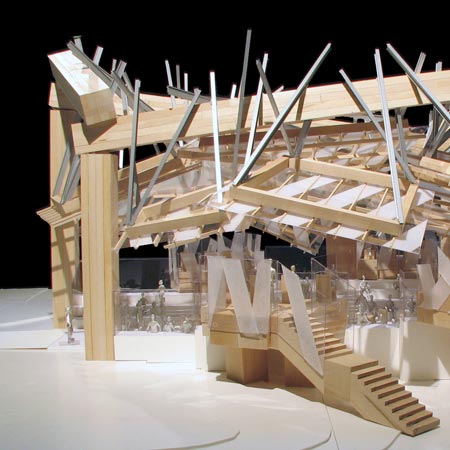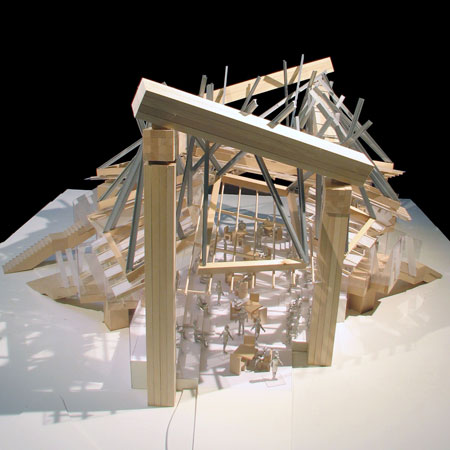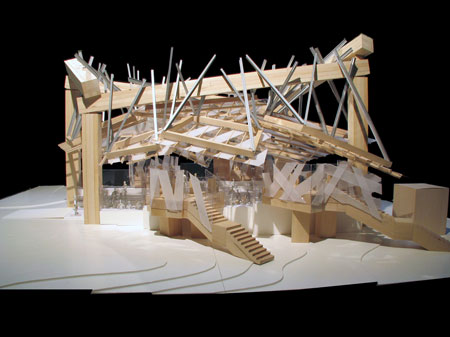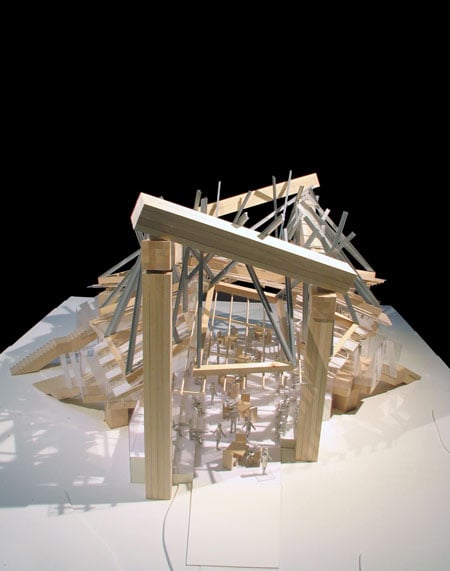
Serpentine Gallery Pavilion 2008 by Frank Gehry
Here are a couple of model photos of the Serpentine Gallery Pavilion 2008, designed by Frank Gehry. Update: this project is included in Dezeen Book of Ideas, which is on sale now for £12.

The pavilion will be built beside the Serpentine Gallery in London this summer and is the latest in a series of temporary pavilions designed by architects including Zaha Hadid, Toyo Ito and Rem Koolhaas.

See our stories on last year's pavilion, designed by artist Olafur Eliasson and architect Kjetil Thorsen of Snøhetta, starting here. See all the previous pavilions on the Serpentine Gallery's website here.

Images are © Gehry Partners LLP 2008. Here's the press release from the Serpentine Gallery:
--
The Serpentine Gallery Pavilion 2008 will give London the first example of Frank Gehry’s spectacular architecture. The highly articulated structure – designed and engineered in collaboration with Arup – comprises large timber planks and multiple glass planes that soar and swoop at different angles to create a dramatic multi-dimensional space. Part-amphitheatre, part-promenade, these seemingly random elements will make a transformative place for reflection and relaxation by day, and discussion and performance by night.
The Serpentine Gallery Pavilion series, now entering its ninth year, is the world’s first and most ambitious architectural programme of its kind, and is one of the most anticipated events in the international design calendar. Frank Gehry said: “The Pavilion is designed as a wooden timber structure that acts as an urban street running from the park to the existing Gallery. Inside the Pavilion, glass canopies are hung from the wooden structure to protect the interior from wind and rain and provide for shade during sunny days. The Pavilion is much like an amphitheatre, designed to serve as a place for live events, music, performance, discussion and debate. As the visitor walks through the Pavilion they have access to terraced seating on both sides of the urban street. In addition to the terraced seating there are five elevated seating pods, which are accessed around the perimeter of the Pavilion. These pods serve as visual markers enclosing the street and can be used as stages, private viewing platforms and dining areas.”
Julia Peyton-Jones, Director, and Hans Ulrich Obrist, Co-Director of Exhibitions and Programmes and Director of International Projects, Serpentine Gallery, said: “Frank Gehry has designed an extraordinary Pavilion that opens up unexpected vistas to the Gallery, and the Park. It is a visionary scheme.”
The Pavilion will be the architect’s first built structure in England. He collaborated for the first time with his son Samuel Gehry.
Since 2001, Peter Rogers, Director of Stanhope, has donated his expertise to all aspects of the Serpentine Gallery Pavilions and he continues to play a major role.
The Pavilion is a fully accessible public space in the Royal Park of Kensington Gardens, attracting up to 250,000 visitors every Summer and is accompanied by an ambitious programme of public talks and events.
Frank Gehry
Raised in Toronto, Canada, Frank Gehry moved to Los Angeles in 1947. He received his Bachelor of Architecture degree from the University of Southern California in 1954, and studied City Planning at the Harvard University Graduate School of Design. In subsequent years, Gehry has built an architectural career that has spanned four decades and produced public and private buildings in America, Europe and Asia. His work has earned him several of the most significant awards in the architectural field, including the Arnold W. Brunner Memorial Prize in Architecture, The Pritzker Architecture Prize, the Wolf Prize in Art (Architecture), the Praemium Imperiale Award, the Dorothy and Lillian Gish Award, the National Medal of Arts, the Friedrich Kiesler Prize, the American Institute of Architects Gold Medal and the Royal Institute of British Architects Gold Medal. Recent projects include the Guggenheim Museum Bilbao in Bilbao, Spain; Maggie’s Centre, a cancer patient care centre in Dundee, Scotland; and the Walt Disney Concert Hall in Los Angeles, California. Some current projects include the Lou Ruvo Alzheimer Center in Las Vegas, Nevada; the Princeton Science Library in Princeton, New Jersey; the Hall Winery in Napa Valley, California; and the Puente de Vida Museo in Panama City, Panama.
Arup
Arup has worked on many of the Pavilions commissioned by Julia Peyton-Jones. Arup collaborated with Gehry Partners LLP to help evaluate the design strategies, choice of materials and structural typology of the 2008 Pavilion. Arup is also providing the engineering and specialist design on the project. The Arup team includes David Glover, Ed Clark with Cecil Balmond.
Serpentine Gallery Pavilion Commission
The Serpentine Gallery Pavilion commission was conceived by Serpentine Gallery Director, Julia Peyton-Jones, in 2000. It is an ongoing programme of temporary structures by internationally acclaimed architects and individuals. It is unique worldwide and presents the work of an international architect or design team who, at the time of the Serpentine Gallery's invitation, has not completed a building in England. The Pavilion architects to date are: Olafur Eliasson and Kjetil Thorsen, 2007; Rem Koolhaas and Cecil Balmond, with Arup, 2006; Álvaro Siza and Eduardo Souto de Moura with Cecil Balmond, Arup, 2005; MVRDV with Arup, 2004 (un-realised); Oscar Niemeyer, 2003; Toyo Ito with Arup, 2002; Daniel Libeskind with Arup, 2001; and Zaha Hadid, 2000. Each Pavilion is sited on the Gallery’s lawn for three months and the immediacy of the process - a maximum of six months from invitation to completion - provides a peerless model for commissioning architecture. This year the project management of the Pavilion is being provided for the Serpentine Gallery by Jonathan Harper, Joanna Streeten and Tim Morse at Savant.
Serpentine Gallery Pavilion 2008:
Advisors: Arup , Stanhope
Project Management: Savant